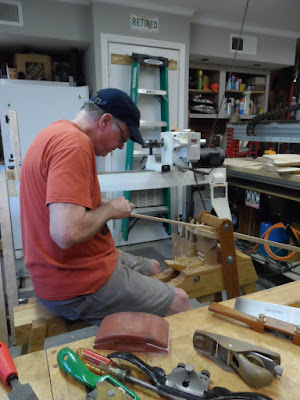My current project is
Curtis Buchanan's Continuous Arm Windsor Chair. One of the main parts and most difficult to construct for me was bending the arm. Since I don't have a ready supply of green wood, nor the space for splitting and riving wood, I thought I would attempt to steam bend kiln dried wood...How hard could that be? Well, it was a waste of time.
 |
| A stubborn woodworker shaping a piece of kiln dried wood for bending. |
I've read that "drying wood in a kiln sets the wood’s lignin"
1, which makes the wood very difficult if not impossible to bend. They recommend green wood or air dried wood
2 for steam bending, both of which I don't have ready access to. I researched the steam bending of kiln dried wood, and came to the conclusion that there might be a chance I could conquer this task. I read all types of articles on the plasticization of wood, and evaluated the diverse methods for achieving this goal in the home workshop. I discovered that plasticization can be achieved by dry heat, steam heat or a combination of steam heat and chemicals. Some of these methods wouldn't be practical for a hobbyist. For example, the use of Ammonia
3 or a Urea-Formaldehyde
4, both of which sounded to dangerous. However, I did run across an interesting technique specifically designed for kiln dried wood that put the wood in a vacuum, and then injected steam
5. This technique proved to be very successful, but impractical for the hobbyist.
My research proved unsuccessful, but I wasn't disheartened. I decided to experiment. Most of the information indicated the moisture content of wood should be between 12-20% for the best bending results
6. Kiln dried wood is normally around 8% depending on the environment. Therefore, I built a vacuum chamber to hold the test pieces under water while I drew a vacuum on the chamber thus saturating the wood. A vacuum was placed on the container for about an hour to soak the wood completely. I let the samples sit in the shop for one day so they wouldn't be soaking wet during the steaming and bending process. Wood cells filled with water are likely to rupture during the bending process. The moisture content of the test pieces the next day was between 12-20%. It was time to steam and bend.
 |
| Vacuum chamber to increase moisture content of kiln dried pieces. |
First, I created several blanks with the same dimensions as the arm in the plans, but without the hand hold. I planned to glue that on after the bending and shaping process. I chose the straightest hickory/pecan stock that I had, and milled the lumber with the straightest grain I could possibly achieve.
 |
| My four test pieces |
Next, I tried steaming a couple of pieces at 1 hr/inch of thickness, and as expected the bends failed as seen below. These bends were made with a bending strap for support. The strap did not help. Bends were made with the strap with small gaps at the end to reduce the possibility of compression fractures. It didn't matter, I experienced all of the bad things you dread to see when I attempted to bend this wood. After trying to bend six or seven of these test pieces unsuccessfully, I gave up.
 |
| Separation Fracture |
 |
| Compression Bend |
 |
| Split |
BENDING GREEN WOOD
After some research, and conversations with other woodworkers, I was directed to
Elia Bizzarria's website
Hand Tool Woodworking and a source of green wood. I purchased enough wood for four arms, and I must admit I really enjoyed working with green wood. As you can see from the photos below, I successfully shaped and bent all four arms.
 |
| Stubborn woodworker shaping Continuous Arm with green oak. |
 |
| A successful bend |
 |
| Another successful bend, and my lovely helper |
 |
| Success |
- 7 Secrets of Steam-Bending; Bend Furniture parts perfectly without fail, Fine Woodworking, by Michael C. Fortune, pg 63, 2011
- 7 Secrets of Steam-Bending; Bend Furniture parts perfectly without fail, Fine Woodworking, by Michael C. Fortune, pg 63, 2011
- Stabilizing and Bending of Wood for the Hobbyist, Todd F. Shupe, Ph.D., LSU AgCenter Research & Extension, Pub. 2643: pg 7-8, December 2010
- Forest Products Laboratory Urea-Plasticized Wood (Uralloy), US Dept of Agriculture Forest Service, in cooperation with the University of Wisconsin, pg 1, August 1943
- Steam Bending of Wood; Embellishments to an Ancient Technique, Wright, Bond, & Chen, BioResources.com 8(4), pg 4795-4796, 2013
- Wood Handbook; Wood as an Engineering Material, US Dept of Agriculture Forest Service, Rebecca E. Ibach, pg 19-4, March 1999











No comments:
Post a Comment